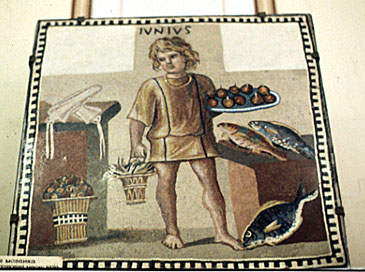|
|
Chapter 1: Scintilla in casa laborat
Verbs: transitive & intransitive; 1st conjugation, 3rd sing.; est + complement; nouns & adjectives: 1st declension sing. nom & acc.
| Roman mosaic of servant boy in kitchen scene (with figs, fish, etc.)
St. Petersburg, Hermitage Museum. Credits: Barbara McManus, 1988. From VRoma Image Archives. |

|
In any language, comprehension is surer when you recognize the basic structure of the language. In Chapter 1 you have met four basic sentence patterns:
SV (Subject-Verb) pattern, with an expressed subject and a verb,
SVC (Subject-Verb-Complement) pattern, with an expressed subject, a linking verb ("is"), and a complement (predicate noun or predicate adjective),
SOV (Subject-Object-Verb) patterns. These can be referred to as SV, SVC, SOV. (Note that English is referred to as a SVO language, whereas Latin is SOV), Subject-Verb-Object,
S+V (unexpressed subject plus verb alo, or with complement, or with object.
In this exercise, identify which of the four patterns each Latin sentence is, answering SV or SVC or SOV or S+V where appropriate.
In this exercise, supply the correct Latin word from Chapter 1 vocabulary.
In this exercise, supply the correct ending for each noun, nominative or accusative case, depending on whether it is the subject, complement, or object.
|